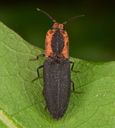Agrypninae
Agrypninae
Classification
- Phylum: Arthropoda
- Subphylum: Hexapoda
- Class: Insecta
- Order: Coleoptera
- Suborder: Polyphaga
- Superfamily: Elateroidea
- Family: Elateridae
- Subfamily: Agrypninae
Pronunciation
How to pronounce Agrypninae: /ˌæɡrɪpˈnaɪniː/
These audio files are automatically generated. While they are not always 100% accurate, they are a good starting point.
Images






Summary
Agrypninae is a diverse subfamily of click beetles recognized for their distinctive clicking behavior, spanning at least 130 genera and over 430 species. They contribute significantly to the ecosystem as decomposers, found globally with a rich variety in different habitats.
Physical Characteristics
Members of the subfamily Agrypninae exhibit a characteristic elongated body shape and are known for their ability to click or leap when they are disturbed. They typically have hard exoskeletons which vary in color, often displaying shades of brown, black, or metallic hues.
Identification Tips
Identification can be aided by examining the unique body shape, coloration, and the distinctive clicking mechanism they employ. Observation of their habitats and behavior can also assist in differentiating them from other beetles.
Habitat
Agrypninae species are generally found in a variety of habitats including forests, grasslands, and wetlands, often associated with decaying organic matter.
Distribution
The distribution of Agrypninae is mostly worldwide with a significant presence in temperate regions. In our area, there are about 100 species across approximately 17 genera.
Diet
Agrypninae larvae are typically detritivores, feeding on decomposing organic matter, while adults may be found feeding on plant matter including leaves.
Life Cycle
The life cycle of Agrypninae includes egg, larval, pupal, and adult stages, with larvae developing in soil or decaying materials.
Reproduction
Reproduction occurs via external fertilization with females laying eggs in soil or decaying organic matter where larvae can later thrive.
Predators
Natural predators of Agrypninae include birds, small mammals, and other insectivorous creatures that consume beetles.
Ecosystem Role
Agrypninae play an essential role in the decomposition of organic matter, contributing to nutrient cycling in their ecosystems.
Collecting Methods
- Hand collection during day or night
- Trapping using pitfall traps
- Light traps to attract nocturnal species
Preservation Methods
- Storing in ethanol
- Drying and placing in insect display boxes
- Freezing to kill specimens prior to permanent storage
Evolution
Agrypninae is categorized under the family Elateridae and represents an evolutionary branch that displays specialized adaptations for their ecological roles as detritivores.
Similar Taxa
- Elaterinae
- Ampedinae
- Agrypnini
- Lissominae
Misconceptions
There may be misconceptions about the harmfulness of click beetles as some people may confuse them with pests; however, most species play vital ecological roles and are harmless to humans.
Tags
- Coleoptera
- Agrypninae
- Beetles
- Ecosystem
- Decomposers